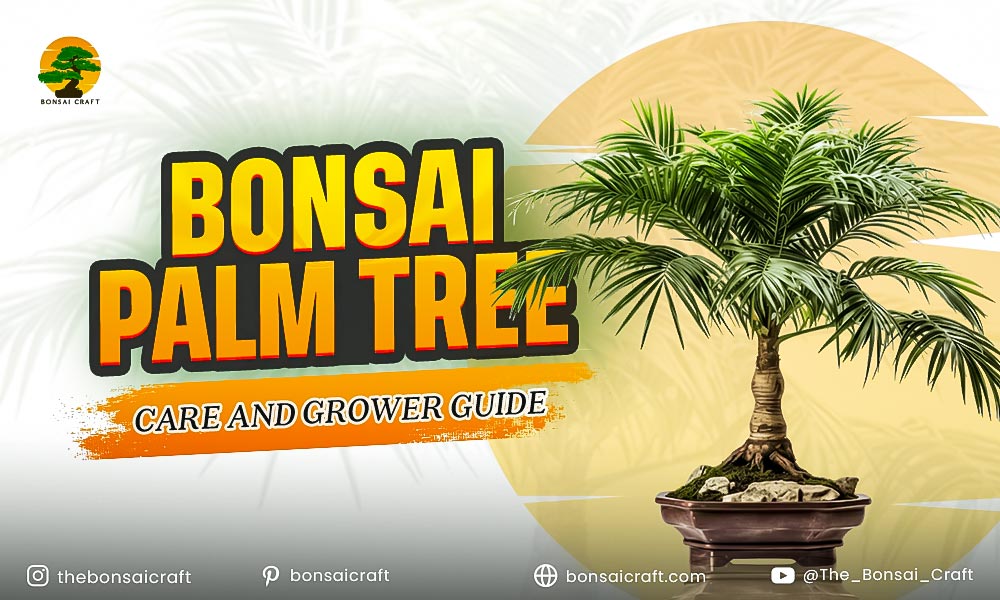
The art of bonsai has long been appreciated for its ability to transform a tiny sapling into a miniature version of a full-sized tree. Among the various bonsai options, the bonsai palm tree is one of the most unique and eye-catching choices. Not only does it bring a touch of tropical elegance to your space, but it also challenges growers with its specific care needs.
If you’re curious about palm bonsai and wondering whether it’s possible to bonsai a palm tree, this guide will provide you with the expert knowledge you need. Whether you’re cultivating a bonsai palm, learning how to trim a ponytail palm bonsai tree, or aiming to master the art of creating a palm tree bonsai, you’ve come to the right place.
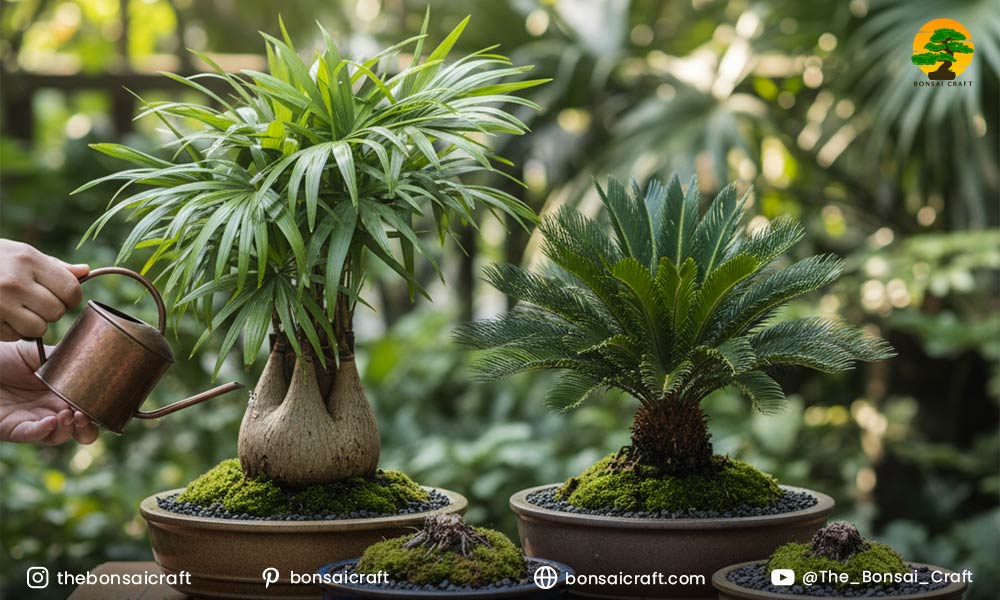
Why Bonsai Palm Trees Are Worth Growing
Bonsai palm trees are different from the traditional bonsai palm trees that are made from junipers and maples. They are much more exotic and appealing, making the palm’s tall slender trunk and tropical palm fronds easy to maintain and appealing to bonsai lovers. Once the owners understand the palm’s needs, the palm trees are also easy to take care of.
If you’ve ever asked yourself, “Can you bonsai a palm tree?” the answer is yes, but with a few considerations. Palms, like ponytail palms and sago palms, have unique growth patterns that require specific care methods, from watering to shaping. By following the correct guidelines, you can nurture a bonsai palm that complements any indoor or outdoor space.
How to Grow and Care for a Bonsai Palm Tree
Every palm tree species is different and so it is important to understand that growing a bonsai palm tree will require an understanding of caring for ponytail and sago palms. Key elements of care are choosing the right bonsai palm tree container, finding the right balance of soil and moisture, and choosing the right amount of sunlight.
Bonsai palms, with their subtle sophistication, require their owners to manage light exposure, watering, and trimming with the utmost care. Even though you will care for the palm slowly and with the intent to control its growth, it will still bloom in all of its splendor.
Here’s a guide on how to make a bonsai palm tree thrive:
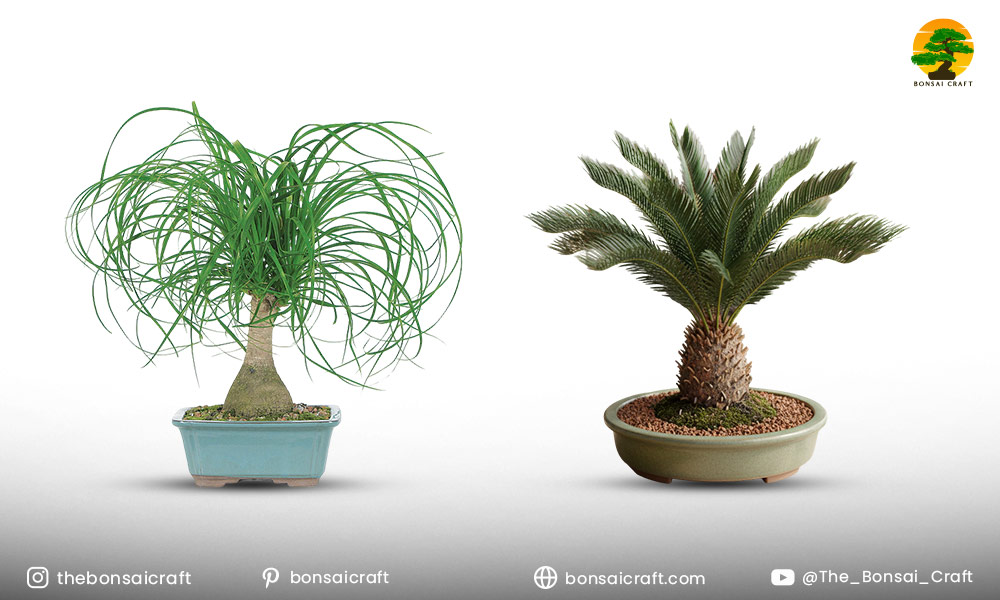
1. Choosing the Right Palm Species for Bonsai
Not all palm trees are suitable for bonsai cultivation. However, several types of palms work exceptionally well in bonsai form:
- Ponytail Palm Bonsai: This palm, known for its bulbous base and slender, curly fronds, is an ideal choice for bonsai due to its slow growth and striking appearance.
- Sago Palm Bonsai: Though technically a cycad, the sago palm bonsai is a popular choice for those wanting a more rugged, ancient look with its thick trunk and feathery fronds.
2. Choosing the Right Bonsai Pot
The container for your bonsai palm should be slightly larger than the root ball to allow for adequate root growth. Ensure it has proper drainage holes to prevent waterlogging, which can lead to root rot.
3. Soil and Repotting
Use a well-draining soil mix, such as a combination of cactus soil and sand, to mimic the conditions of a palm’s natural habitat. Repot your bonsai palm tree every two years to avoid root overcrowding and maintain healthy growth.
4. Watering Your Bonsai Palm
Watering is critical for a bonsai palm. These palms do not like to sit in water, so ensure that the soil dries out slightly between watering. In warmer months, water more frequently, but during the winter, reduce watering as the plant enters a dormant phase.
5. Light and Temperature Needs
Bonsai palm trees thrive in bright, indirect light. Place your palm in a location where it can receive at least 4-6 hours of sunlight daily. Avoid exposing it to harsh, direct sunlight, which could burn the leaves.
6. Humidity Requirements
Palms like having higher humidity around them. It is suggested that a humidity tray is placed underneath the bonsai palm, or a humidifier can be used to keep moisture in the air, especially during dry seasons or winter months when the air is dry.
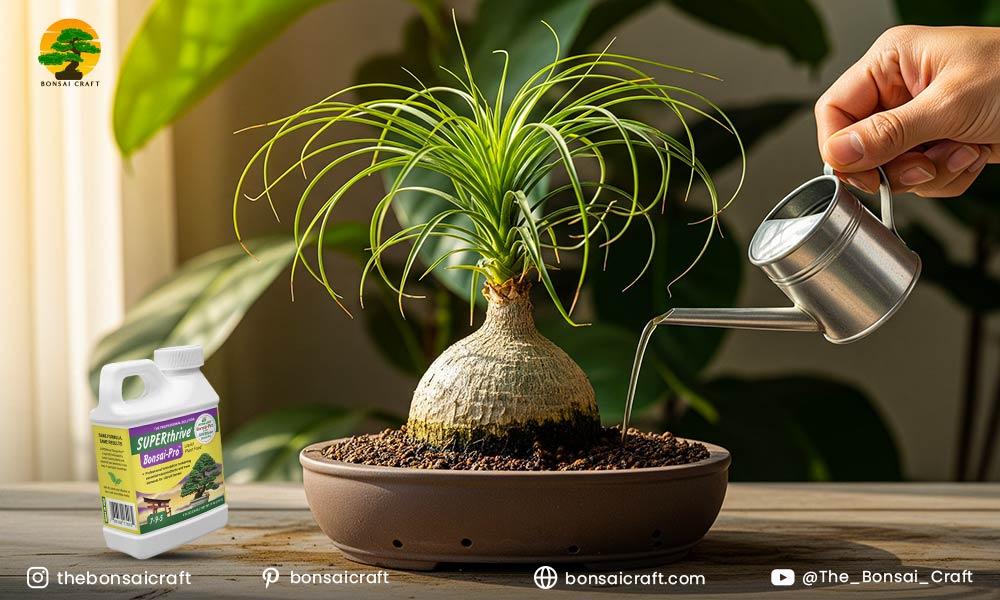
7. Fertilizing Your Bonsai Palm
Fertilize your bonsai palm every two weeks during the growing season with a balanced, liquid fertilizer. In the winter, reduce fertilization as the plant is in a resting phase.
Can You Bonsai a Palm Tree?
Yes, you can bonsai a palm tree, but certain species are more suited to this form than others. Popular choices include the ponytail palm and sago palm, which are known for their manageable growth and unique appearance.
Bonsai is a technique traditionally applied to trees with woody stems, but palms, though not technically “woody,” can be successfully cultivated as bonsai. The key lies in choosing the right species and adopting the correct care practices. While bonsai palm trees do not exhibit the same branching patterns as traditional bonsai, their graceful fronds and distinct trunks make them highly desirable for bonsai enthusiasts.
Bonsai Palm Tree Growth and Pruning
One of the most intriguing aspects of bonsai palm trees is their slow, steady growth. For palms like the ponytail palm, this growth can be controlled through periodic pruning. The fronds can be trimmed to maintain the palm’s shape, and the trunk can be shaped by pruning the roots when repotting.
Shaping Your Bonsai Palm Tree
While traditional bonsai trees are often shaped by wiring, shaping a bonsai palm tree requires a more subtle approach. Instead of bending the trunk with wire, palms can be shaped through pruning and careful management of the tree’s growth. By controlling root growth and trimming the fronds, you can guide the palm’s shape.
How to Care for a Ponytail Palm Bonsai Tree
To care for a ponytail palm bonsai tree, provide bright, indirect light, water sparingly, and keep the soil well-draining. Prune the fronds occasionally to maintain the tree’s iconic appearance.
The ponytail palm bonsai is one of the most popular palm choices for bonsai growers. It is easy to care for and tolerates a wide range of conditions, making it ideal for beginners. Here’s how to care for it:
- Light: Provide bright, indirect light. Avoid harsh sunlight, which can cause the fronds to burn.
- Watering: Water sparingly and allow the soil to dry out between watering. Overwatering can lead to root rot.
- Pruning: Trim the fronds to maintain the desired shape. This palm tends to grow taller, so regular trimming helps it stay compact.
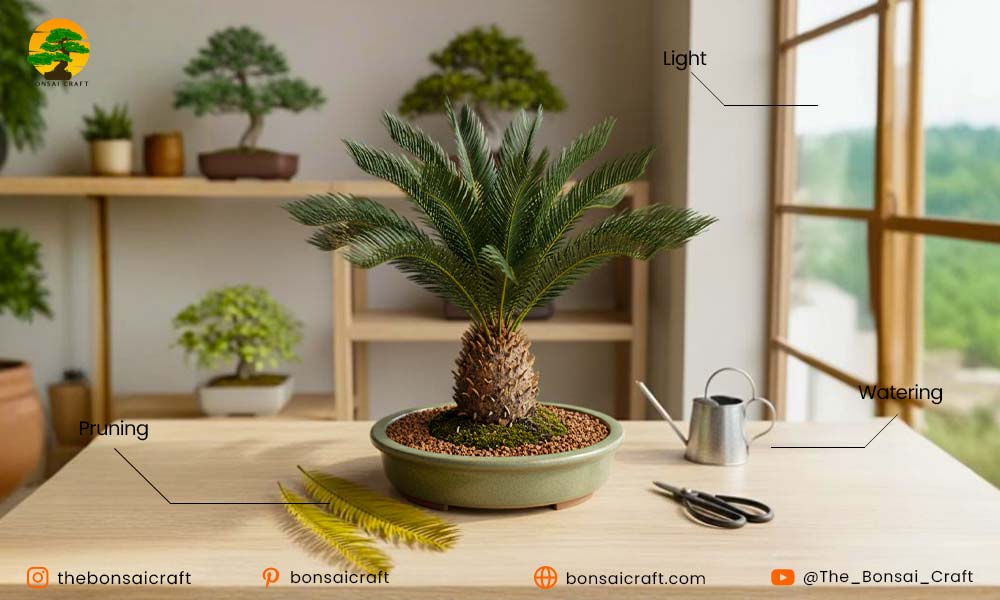
How to Care for a Sago Palm Bonsai Tree
Sago palm bonsai care involves providing bright light, well-draining soil, and periodic pruning. Like the ponytail palm, the sago palm should not be overwatered.
The sago palm bonsai is a cycad, not a true palm, but its striking appearance makes it a popular choice for bonsai. Here’s how to care for your sago palm bonsai tree:
- Light: Place your sago palm bonsai in bright, indirect sunlight. It can tolerate some direct sun but avoid harsh conditions.
- Watering: Water your sago palm bonsai when the topsoil feels dry. Allow the soil to dry between waterings to avoid overwatering.
- Pruning: Prune the fronds carefully to maintain the tree’s aesthetic shape. Remove any dead or yellowing fronds to encourage new growth.
How to Trim a Ponytail Palm Bonsai Tree
Trimming ponytail bonsai trees is simply done by using scissors or shears to cut broken fronds. The cut should aim to make the fronds as short as possible, without reaching the trunk of the tree.
Pruning a ponytail palm bonsai tree is a necessary step that helps keep the tree’s beauty intact. For proper pruning, follow the below:
- Start with sharp instruments: Always use scissors or pruning shears that are sharp so as not to injure the plant.
- Trim dead fronds: Any fronds that are dead or yellowing should be cut to the base. In the process, try not to cut the trunk at the same time.
- Keep the desired outline: Fronds should be cut back to define the shape of the tree. They can be cut back a little more so more fronds will be produced later.
Conclusion: Bonsai Palm Tree Care and Growing Tips
Cultivating and caring for a palm bonsai tree is an art and a dance of separation that requires patience, focus, and love for everything green and alive.
You should keep in mind that each bonsai tree is different. While cultivating a ponytail palm bonsai tree and a sago palm bonsai tree, both will have watering, light, pruning and soil conditions unique to the other.
With the bonsai palm tree care tips, and with the tree being continuously taken care of, you will be able to maintain a little palm tree that can bring an elegant peace to your house.
Expert Tip: Bonsai palm trees are a slow-growing species, so don’t be discouraged by their gradual progress. With the right care, your palm will gradually mature into a beautiful, sculpted masterpiece.
FAQs
Can you bonsai a palm tree?
Yes, a palm tree can be bonsai. The ponytail palm and sago palm are great species for bonsai because of their height and interesting looks.
How do you care for a ponytail palm bonsai tree?
Ponytail palm bonsai care involves providing bright, indirect light, watering sparingly, and trimming the fronds regularly to maintain its shape.
What is the best soil for bonsai palm trees?
The best soil for bonsai palm trees is a well-draining mix that includes cactus soil, sand, or perlite to prevent waterlogging.
How do you trim a sago palm bonsai tree?
To trim a sago palm bonsai tree, cut off dead fronds at the base, and remove any yellowing or damaged fronds to maintain its shape.
How long does it take to grow a bonsai palm tree?
It can take several years for a bonsai palm tree to reach maturity, as palms grow slowly and require consistent care to shape and maintain their appearance.
